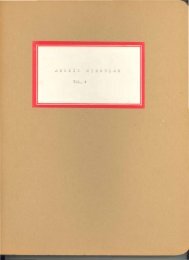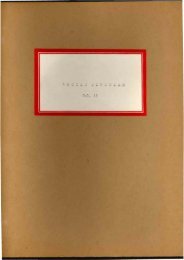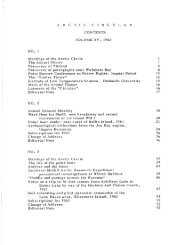".VOL. VIII NO.4 THE ARCTIC CIRCULAR 77average number of eggs per nest was a little over Z, varying between1 and 3. Of 77 Kumlien's Gull eggs known to have been laid,IS, or 19,5 per cent, were lost before hatching. This is a minimumfigure as I have not made allowance for an egg having been laid andlost between observations. No figures are available for chickmortality, which is commonly the major fraction of breeding failurein colonial gulls. During the field season 189 Kumlien1s Gull chickswere banded.Glaucous Gulls, like KumUen's Gulls, usually nested on thesteep cliffs fringing the shore line, frequently, as noted before, inthe company of breeding Kumlien's Gulls. One colony of 4 Glaucousand Z Herring gull pairs was also found. However, they sometimesformed small pure colonies of 5 or 6 pairs and occasionally nestedsingly on shoals or cliffs. Another, though rare, type of nest wasthe solitary nest on a lake boulder - a typical Herring Gull situation(only Z nests in sites of this sort were found, although theyoccur in Newfoundland (.ee Bent, 19Z1, p. 53)). Egg laying beganabout June 1 in one of the four nests under observation but the peakcame about June ZOo No egg loss was ob.erved. <strong>The</strong> first chickhatched on July 1, the majority not before July 15. It is harder toestimate the population of Glaucous than of Kumlien's gulls becauseof the scattered nesting sites; however, it is thought thatthe 106 breeding pairs seen comprised about 80 per cent of thetotal breeding population between Pikiolialuk and Amadjuak, <strong>The</strong>total breeding population is therefore estimated at about 130 pairs.As with Kumlien1s Gull, no breeding pairs were seen fromPikiolialuk north to the Wildbird Islands, although several places,such as Cape Enauolik, appeared to have suitable nesting sites.Forty-four Glaucous Gull chicks were banded..: "'\Most Herring Gull nests were on boulders in small lakes,usually only one or two pairs to a lake. However, three lakeislandcolonies were found with lZ to 30 pairs on each (average 18) •Egg laying began about June 6 and reached a peak about July 10.Breeding Herring Gulls were even more scattered than breedingGlaucous Gulls and only 5 nests were under observation and only6 chicks banded. Judging by comparative numbers seen at the floeedge, Herring and Glaucous gulls probably occur in about the samenumbers. Although a few were collected, immature birds wereuncommon during the nesting season.
VOL. VIII NO.4THE ARCTIC CIRCULAR78ReferencesBailey, A. M. 1948. IBirds of arctic Alaska'. Colorado Mus. Nat.Hist. Fop. Ser. No.8, 317 pp.Bent, A.C. 19Z1. 'Life histories of North American gulls andterns, Order Longipennes l • U.S. Nat. Mus. Bull. 113,345 pp.Rand, A.L. 194Z. "Larus kumlieni and its allies". Can. FieldNat. Vol. 56, pp. lZ3 -6.Salomonsen, F. 1950-1. '<strong>The</strong> birds of Greenland'. Copenhagen,608 pp.A second trip to King William Island. By Faul F. CooperIn August <strong>1955</strong> the writer, accompanied by his wife and son,Paul F. Cooper, Jr., made a second flight to King William Islandwith Charlie Weber of <strong>Arctic</strong> Vlings (for an account of the 1954 trip,see Circular, Vol. 8, No.1, pp. 8-11). It was planned, if possible,to set up camp on the northwest coast of the island, somewherebetween Wall Bay and Cape Felix, and to search that area forrelics of the Franklin expedition. Unfortunately, bad weather sohandicapped us everywhere that in the end the trip turned out to bemore notable for what was not accomplished than for what was.We left Churchill on the afternoon of August 13. Owing tobad flying conditions and ice in the harbour at Gjoa Haven, it wasthe morning of the 15th before we could come in to that post. <strong>The</strong>next day, accompanied by Father Henry, we flew up the east coastof King William to Cape Felix, then started down the west coast,hoping to find a place to land. Fog, however, soon enshrouded us,leaving nO choice but to continue southward to where it was clearand come down on a lake just north of Cape Jane Franklin, about amile inland from where Crozier and his men camped afterabandoning the Erebus and Terror in April 1848. Here bad weathersoon closed in, grounding our party for four days and three nightsand vividly calling to mind M'Clintock's experience on that part ofthe island, where "the air was almost constantly loaded withchilling fogs." On the morning of the 19th, taking advantage of aclear spell, Charlie Weber and my son flew back up to Cape Felix,only to be driven away again by fog. This ended all efforts to reach
- Page 1 and 2:
Vol. 8CIHCULJ-..R
- Page 3 and 4:
CONTENTSVol. VIII, 1955NO.1Meetings
- Page 5 and 6:
•THE. dRCTIC CIRCULARVOL. Vlll NC
- Page 7 and 8:
veL. Vlll NC. I THE ,."ReTIe CIRCUk
- Page 9 and 10:
VGL. VIll NC. I THI;; rl.RCTIC cm.C
- Page 11 and 12:
VOL. Vlll NC. ITHE ,.RCTIC CIRCULn.
- Page 13 and 14:
oQ\CROZIER's LANDING Pl.AC£(VlCTOR
- Page 15 and 16:
veL. VIII NC. I THE ARCTIC ClRCULh.
- Page 17 and 18:
VOL. vm NC. r TH£ .·.BoCTIC CIRCU
- Page 19 and 20:
VOL. VIII NO. I THE ARCTIC CIRCULaR
- Page 21 and 22:
VOL. VIII NO. I THE ARCTIC CIRCULAR
- Page 23 and 24:
•THE ARCTIC CIRCULARVOL. VIII NO.
- Page 25 and 26:
VOL. VIII NO. Z THE ARCTIC CIRCULAR
- Page 27 and 28:
VOL, VIII NO. 2 THE ARCTIC CIRCULAR
- Page 29 and 30: VOL. VIII NO.2 THE ARCTIC CIRCULAR
- Page 31 and 32: VOL. VIII NO.2 THE ARCTIC CIRCULAR
- Page 33 and 34: 23 4 56 7 89 10•'OSTE. CAN A D
- Page 35 and 36: VOL. VlU NO. Z THE ARCTIC CIRCULAR
- Page 37 and 38: VOL. VIII NO.2 THE ARCTIC CIRCULAR
- Page 39 and 40: VOL. Vlli NO. Z THE ARCTIC CIRCULAR
- Page 41 and 42: VOL. VIII NO. ZTHE ARCTIC CIRCULAR3
- Page 43 and 44: VOL. VlII NO.3THE ARCTIC CIRCULARA
- Page 45 and 46: VOL. YIll NO.3THE ARCTIC CIRCULAR4"
- Page 47 and 48: VOL. VIIlNO. 3THE ARCTIC CIRCULAR6-
- Page 49 and 50: VOL. Vlli NO.3THE ARCTIC CIRCULAR8G
- Page 51 and 52: VOL. VllI NO.3THE ARCTIC CIRCULAR10
- Page 53 and 54: VOL. YIU NO.3 THE ARCTiC CIRCDLAR 1
- Page 55 and 56: VOL. VIII NO.3THE ARCTIC CIRCULARCo
- Page 57 and 58: VOL. VlII NO.3THE ARCTIC CIRCULAR16
- Page 59 and 60: VOL. VIII NO.3 THE ARCTIC CIRCULAR
- Page 61 and 62: VOL. VIn NO.3 THE ARCTIC CIRCULAR 2
- Page 63 and 64: VOL. VIII NO.3 THE ARCTIC CIRCULAR
- Page 65 and 66: VOL. VIII NO.3THE ARCTIC CIRCULAR2.
- Page 67 and 68: VOL. VIII NO.3THE ARCTIC CIRCULAR
- Page 69 and 70: VOL. VIll NO.3THE ARCTIC CIRCULAR2.
- Page 71 and 72: VOL. VIII NO.3 THE ARCTIC CIRCULAR
- Page 73 and 74: THE ARCTIC CIRCULARtVOL. VllI NO.4
- Page 75 and 76: VOL, VIII NO.4THE ARCTIC CIRCULAR72
- Page 77 and 78: VOL. VIII NO.4THE ARCTIC CIRCULARFi
- Page 79: VOL. vm NO, 4THE ARCTIC CIRCULAR76B
- Page 83 and 84: VOL. VIII NO.4THE ARCTIC CIRCULAR80
- Page 85 and 86: VOL. VIII NO.4 THE ARCTIC CIRCULAR
- Page 87 and 88: INDEX TO VOLUME VIII, 1955AActiviti
- Page 89 and 90: --86 Ellesmere Ice Shelf exped" 5
- Page 91 and 92: -.88 NNares, Capt. Sir George, Pa
- Page 93: ,-~-- 90 Walrus, Atlantic, in Can












